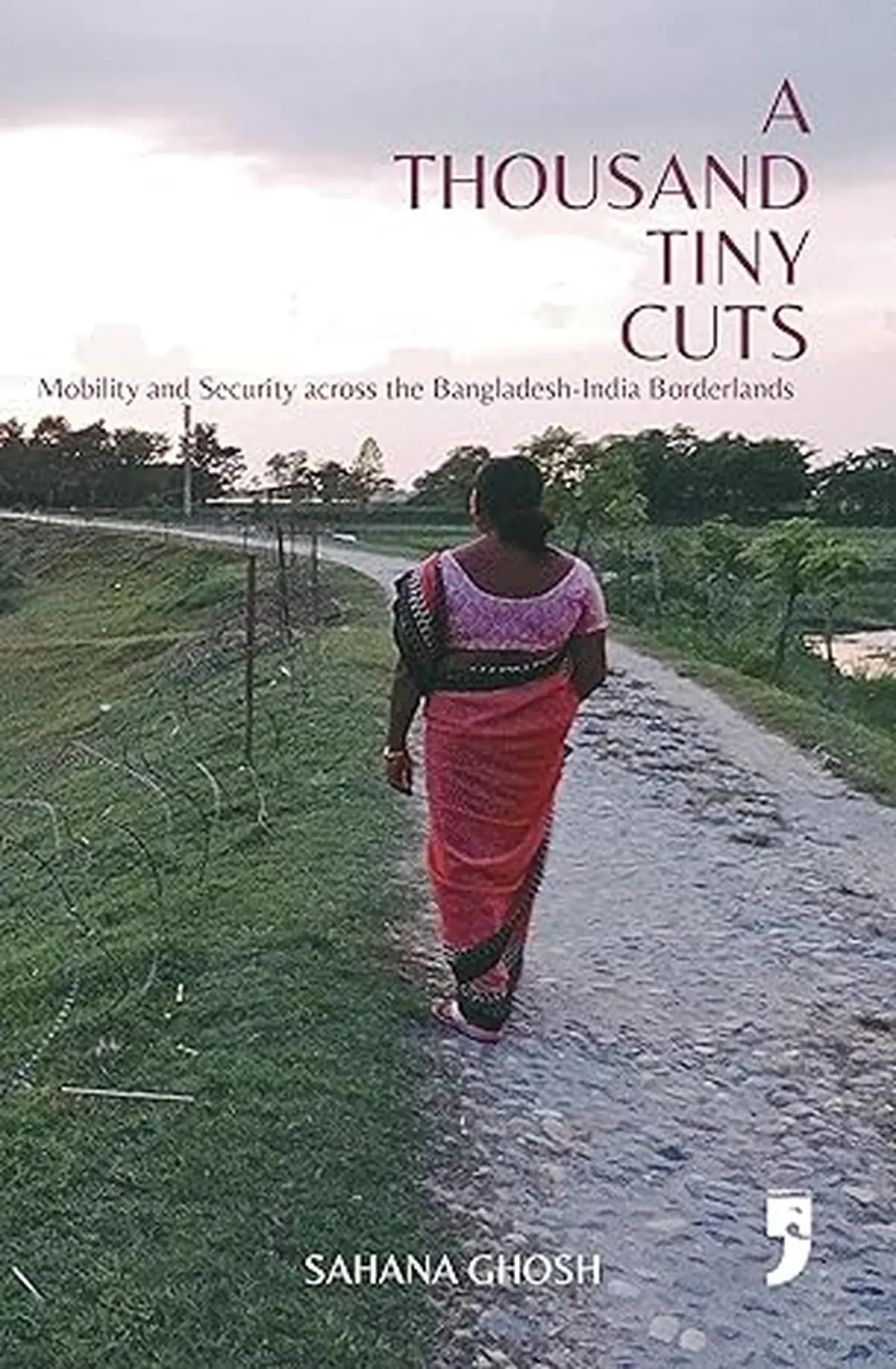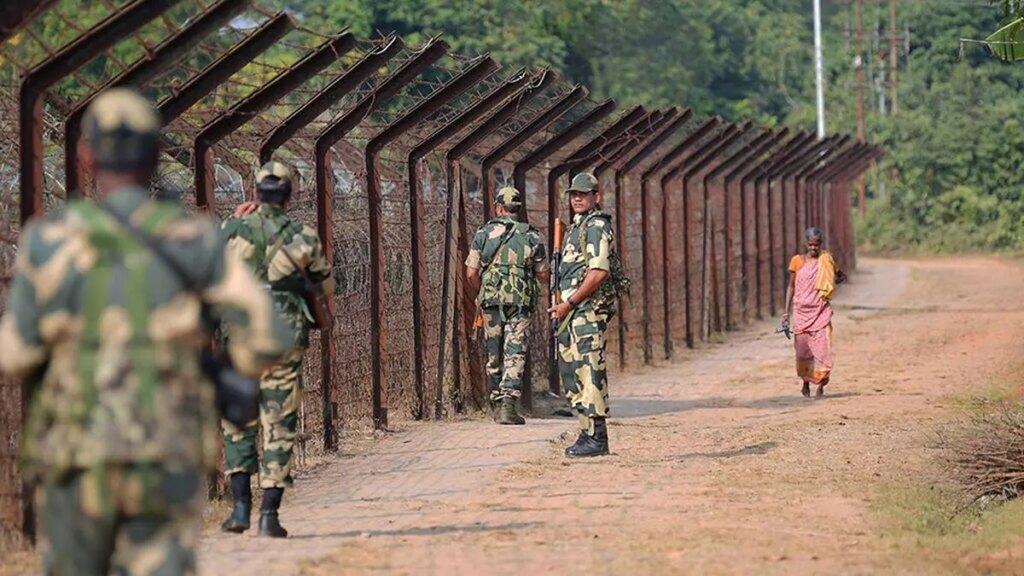
The Indo-Bangladesh border at Lankamura village, Tripura, on December 14, 2018.
| Photo Credit: Abhisek Saha
A book that revisits the history of the creation of India’s borders with Bangladesh through contemporary lived experiences seems timely, coming as it does in these days of such violent upheaval in our neighbouring country, and could be useful to a lot of us invested in this current exigency. A Thousand Tiny Cuts is essentially a collage of the “quintessential simantojibon”—the everyday hardships of ordinary borderland citizens in the light of national security—stitched together by Sahana Ghosh as a way of narrating her field visits at the border between West Bengal’s Cooch Behar district and the corresponding Lalmonirhat district of Bangladesh.
Although set in the grim security paraphernalia of the borders, the book is more about interesting and often subversive patterns of transnational connections and clandestine crossings. The understanding of the border as both “a risk and a resource” and as “devaluing and productive at the same time” lies at the heart of this monograph. Through her insightful observations and analysis of the lives of the people along and across the north Bengal border, Ghosh untangles the complex trajectories of surviving the border and living against the backdrop of increasing militarisation.
Also Read | The first of Bangladesh’s many military coups
A Thousand Tiny Cuts is an addition to the existing genre of ethnographies of the Bengal border, beginning with Willem van Schendel’s formative book on the same, followed by a number of studies by scholars who have covered a range of issues, geographies, and spatial trajectories. Ghosh’s work makes an intervention in South Asian borderland studies more in its selection of the indices through which this border is studied rather than by any methodological interjection. Having said that, Ghosh’s assertion on “walking as a method” calls for revisiting the notion of ethnographic fields as static or confined to a given geographical area. She uses walking, loitering, and stopping as practices worth an ethnographer’s observation and analysis and tactfully puts these tools to use in shaping the framework for a “mobile ethnography”.
Mobile ethnography
Ghosh compellingly uses mobile ethnography in laying out the possibilities of a feminist epistemology and praxis—by way of gendering the mobile bodies, by “seeing [the] body as a political instrument and diagnostic”. A gendered understanding of bodies crossing borders, again, is in itself not new in studies of the Bengal borderland, as is evident from the works of van Schendel, Malini Sur, or to some extent Rimple Mehta (though her primary subjects of concern are the incarcerated women from Bangladesh who have crossed the Bengal border).
A Thousand Tiny Cuts: Mobility and Security across the Bangladesh-India Borderlands
By Sahana Ghosh
Yoda Press, 2024
Pages: 297
Price: Rs. 699
Then again, Ghosh’s use of very different tools of mobility adds to our understanding of national borderlands through “normative claims about social and economic life”. Cross-border kinship ties is also foregrounded as integral to this process of gendering border mobilities, creating counter or “alternative border maps” (Matthew Wilkinson, Borderland Anxieties) of kinship geographies.
The other important highlight of Ghosh’s attempt at engendering border mobile ethnography is the often-trivialised reluctance of women towards mobility and their lack of agency in deciding whether they want to be part of the movement—as a family, as a labour, as a commodity. In studies of migration, it is often the experiences of women during and after migration, and not so much their agency and autonomy in the pre-migration decision-making, that are the most discussed. Ghosh talks at length about how women often find themselves in dire conditions in a practice (of cross-border mobility) in which they are reluctant participants.
Discourses on gendering borderland mobilities need not necessarily be about women alone, as Ghosh shows when she locates “masculine becoming” in the borderland context at the intersection of transnational consumption, relational value, and the risks of labour. Transnational chahida (demand) manifests itself as local economies that cuts across the border, deciding not just the daam (value) of a commodity of consumption but also the risk that local borderland people undertake in response to that demand. The nature of labour (and the risk associated with it) decides the image of the person involved, engendering the labour in the process.

Ghosh’s book, as the title suggests, is about a “thousand tiny cuts across time, space and imaginaries”.
| Photo Credit:
By Special Arrangement
Ghosh’s discussion of the social networks that define and decide borderland mobilities and cross-border interactions is geared towards explaining, using Sharika Thiranagama’s work, how “social life is thicker than survival tactics” when it comes to surviving the everyday violence of the border. It also hints at the continuity of the pre-Partition social networks despite the creation of the border and the many risks of defying the line.
In view of my own experiences of having conducted field studies at the Bengal borders, the evolving sociopolitical and economic character of the Bengal border has ensured that social life is, in fact, survival tactics. The overwhelming immediacy of surviving the borders decides and shapes the kind of socio-political character that the border lives and networks will take. Kinship geographies persist, only to be affected and modified by the demands of surviving the border. This explains the kind of survival networks that run across the border and cut across sociopolitical groups: an “imagined community” held together by the spatial specificity of the borderland.
Also Read | India’s eastern strategy: A history of mixed messages
One of the many important contributions the book makes is to the citizenship discourse and to the evolving narrative of the journey that a refugee must make to emerge as the “valid” citizen of a nation. The spatial specificity of the borderland gives a kind of uniqueness to the already complex web of identities that the border residents find themselves in, which has a far-reaching impact on the imagination of every person about every other as to the validity of existence. To this is fed the imagination of the state leading to a framework and definition of who is eligible to stay within the boundaries of the nation-state.
The border-making process in this part of South Asia, which began with Partition in 1947, continues through its everyday border making and re-making process—making Partition a lived reality, a present continuous. The existing and newly developing links across the Bengal border—the kinship networks that Ghosh so eloquently charts—are proof of the continuity of the Partition trajectory in the everyday links and mobilities across the said border. The acts of both belonging within boundaries and moving across them decide identities for a person in these complex geographical spaces—deciding, in the process, how the person is imagined and accepted (or rejected) by the nation and its people. A Thousand Tiny Cuts is a well-laid-out and beautifully descriptive narrative of such belongings and mobilities.
Ghosh’s book is an unfolding of the everyday mobilities and connections across the border and the lived experiences of the borderland people rather than any epochal or watershed event. It is, as the title suggests, about a “thousand tiny cuts across time, space and imaginaries”. At a time when nation-making is increasingly at odds with the practice of neighbour-making, A Thousand Tiny Cuts is a step towards rewriting histories of nations and nationalisms. It is a reminder that the idea of the “national neighbour” could still be a reality if the ties—of kinship, need, and survival—are made the basis of our interactions, and plurality rather than forced homogeneity becomes the binding factor.
Debdatta Chowdhury is Assistant Professor in Gender Studies, Centre for Studies in Social Sciences, Kolkata.
Source:https://frontline.thehindu.com/books/book-review-a-thousand-tiny-cuts-sahana-ghosh-indo-bangladesh-border/article69265740.ece

